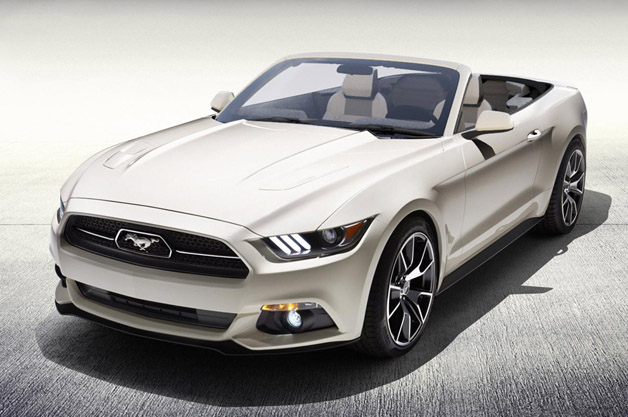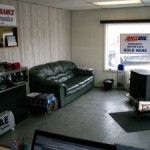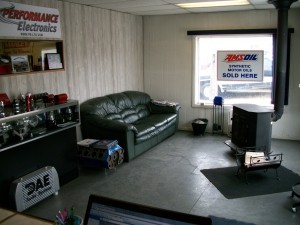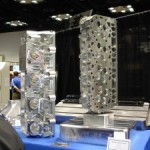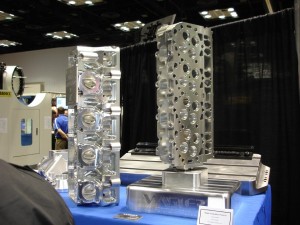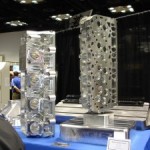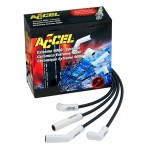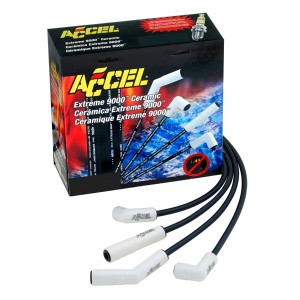A cylinder head is much more than a casting that tops off the block, holds the valves and forms the combustion chambers. The head works in combination with the camshaft, induction and exhaust systems to determine how the engine breathes, the engine’s power curve and personality. The “right” cylinder head on an engine will deliver peak power in the RPM range where you want it. The engine will have good throttle response and produce the kind of torque and horsepower numbers you want. Head selection, therefore, is a key ingredient in building a winning performance engine.
Let’s start with the basics. Assuming you are going to choose an aftermarket cylinder head, you have to find out what’s available for the engine you want to build. For popular engines like small block and big block Chevy, Ford and Chrysler engines, there are dozens of head configurations, brands and product lines from which you can choose. The selection can be so overwhelming that sometimes it comes down to eenie, meenie, minee, moe to pick a head.
Some people pick a set of cylinder heads based on name brand, previous experience or word-of-mouth recommendations. Some will shop around for the least expensive set of heads that promise to meet their expectations. Others will make their selection based strictly on which set of heads claims the highest air flow numbers. But there’s a lot more that should be considered when choosing a set of cylinder heads.
Determine The Venue
Price, performance and availability are all important considerations in the head selection process. But equally important is choosing a set of cylinder heads that are right for the engine and the application. Building a street performance engine is different than building a circle track engine, a drag engine, a marine engine, or a truck pull engine.
Each type of application has its own unique requirements, so the heads have to have the right flow characteristics for that application.
Basic considerations include such variables as engine displacement, compression ratio, camshaft lift and duration specifications, RPM range (where the engine should make the most horsepower and torque), and target horsepower (be realistic!).
You also need to consider vehicle weight, type of transmission (manual or automatic), torque converter stall speed (if automatic), gearing (transmission and differential), and most importantly the application itself (street, street/strip, drag, circle track, road race, off-road, etc.).
Street engines spend most of their time between idle and part throttle so they must have good low and mid-range torque and throttle response to be drivable — especially in heavier cars with automatic transmissions. For this type of application, you want a set of heads with stock to moderately larger intake runner volumes to keep air velocity high. Peak valve lift is probably going to be no more than about half an inch with a typical street cam, so a set of heads that claims huge airflow numbers at extreme valve lifts would not be your best choice. Too much head can be counter productive in this type of application.
A drag engine runs at full throttle for a quarter mile. For this kind of application, you want lots of valve lift, duration and airflow at high RPM. Bigger is better in terms of intake runner volumes, valve size and peak airflow numbers provided the engine has the cam, induction system and cubic inches (or boost pressure) to handle it.
Bolt-on horsepower for street performance engines (such as this Edelbrock head) take the guesswork out of choosing a performance head.
Circle track engines are usually rule constrained. Some tracks only allow cast iron heads depending on the class. If we’re talking small block Chevys, some rules only allow heads with stock port locations and stock 23 degree valve angles. Others may allow any head configuration with raised ports and shallower valve angles. A shallower valve angle helps unshroud the valve for more airflow and power. For circle track engines, heads that deliver good mid to high RPM throttle response and torque out of the corners will usually win more races than heads that deliver more peak RPM horsepower.
Every cylinder head manufacturer offers a variety of different cylinder heads for this reason. They offer heads with various intake runner volumes, stock and raised port locations, various intake and exhaust port configurations, valve sizes, valve angles, combustion chamber volumes and spring pad sizes to accommodate a wide variety of possible applications. Some manufacturers concentrate on a narrow segment of the market (high end race only, street/strip, circle track, etc.) while others offer a broader range of products.
The people who make aftermarket performance cylinder heads know their product lines and can provide the kind of guidance that’s often needed to choose the right head combination. “The most common mistake people make is wanting the biggest head that will fit their engine,” said one head manufacturer we interviewed for this article. Other manufacturers agreed. “Bigger isn’t always better. Just because a head makes a lot of power on Bubba’s engine doesn’t mean it’s the right head for your engine.”
The Numbers Game
All too often, the only thing people look at are flow numbers. Yes, flow numbers make horsepower, but you have to keep in mind how the flow numbers were determined on a flow bench. If you hog out the intake ports and shove the valve open far enough, many heads can deliver impressive flow numbers. But if those numbers are rated at .700 inches of valve lift and the engine you are building only has half an inch of valve lift, you are better off choosing a head that flows best at .400 to .500 inches of valve lift.
According to one head manufacturer, good airflow numbers measured at .200, .400 and .500 inches of valve lift are the most important for a street performance engine.
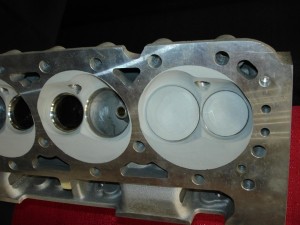
Heat reflecting thermal coatings applied to combustion chambers in aluminum heads improve thermal efficiency and horsepower.
As for intake runner volume, generally speaking, smaller intake port volumes produce more low-end torque and throttle response while larger intake port volumes allow more flow at higher RPMs for peak horsepower numbers.
But airflow also depends on runner height (raised ports typically flow better), the contour of the port (especially the profile of the short side radius where the runner flows into the bowl area above the valve), the cross-sectional area of the intake runner and its relationship to the size of the valve opening, the angle of the valve stem (shallower usually flows better), and
the angles on the valve seat and valve face. The shape of the combustion chamber can also influence airflow.
Every head manufacturer and head porter has their own recipe for combining these factors to squeeze the best performance out of a given cylinder head. You can take two cylinder heads from different suppliers that have identical intake runner port volumes and valves and end up with very different airflow and horsepower numbers. Why? Because the profile of the intake runners in one head flow better than the other. Consequently, one set of heads may deliver 15 to 20 more horsepower on the same engine than a competitor’s heads.
When choosing a cylinder head for a particular engine application, one of the first variables that has to be considered is engine displacement. Are you building a 350 with stock bore and stroke, or a 383 stroker or something bigger? The more cubic inches the engine has, the more airflow the heads have to deliver.
A head with 180 or 185cc intake runners will work well on a typical 350 Chevy street engine that makes 400 to 450 horsepower. If it’s a 383 stroker, you can probably go with 200cc intake runners.
Putting a higher flow head with 220cc runners on a relatively stock 350 would be going in the wrong direction.
On the other hand, if you’re building a high revving race engine, or a big displacement stroker (over 400 inches), you could probably go with larger runners for increased airflow. Some aftermarket SB Chevy racing heads have intake runner volumes from 240 to 270cc or more!
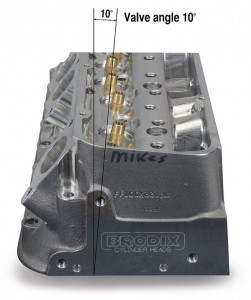
Last year, Mike Androwick’s big-block head designs won the Northeast Dirt Modified championship. According to Androwick, one of the two chief advantages of using a low, 10-degree valve angle is that it yields a shallow combustion chamber.
Source: www.mooregoodink.com
If you’re building a big block Chevy street performance engine, heads with 300 to 320cc intake runners will probably work best. Again, the larger the displacement, the more intake volume and airflow the engine needs.
On the other hand, if you’re building a 565 cubic inch big block stroker motor, you’ll probably want heads with 330 to 340cc intake runner volumes. If it’s a drag motor, you can go even bigger, maybe 350 to 360cc with a CNC-ported head. It all depends on the cam, RPM range and where you want the engine to make the most power and torque.
Aluminum vs. Cast Iron
Aluminum heads are lighter than cast iron, saving maybe 25 to 30 lbs. per head depending on the application. In a 3500 to 4500 lb. street car, that’s not a lot of weight savings, but in a 2,500 lbs. race car it is. Even so, lighter is usually considered better for performance.
Aluminum heads are easier to machine than cast iron because the metal is softer, and the heads are easier to repair because aluminum can be TIG welded to fix cracks and other damage.
Cracks in cast iron can be drilled and pinned, or even furnace welded, but the latter is more difficult and requires a high level of skill and experience to prevent repeat cracking.
Aluminum may be your only choice if you want a custom billet head. Billet aluminum heads can be made for almost anything, but are very expensive because of all the machine work that is required to design and fabricate the head.
This is what the big boys use on many top fuel dragsters and some Pro Stock mountain motors because nothing else will work. We’ve also seen some very slick billet aluminum heads for diesel engines used in Super Stock Pulling Tractors.
Aluminum conducts heat faster than cast iron. This helps cool the engine and allows a higher compression ratio with less risk of preignition or detonation — but it also sucks heat out of the combustion chamber and actually reduces combustion efficiency somewhat. At high RPM, there’s less time per combustion event for heat to escape through the cylinder head so the loss in thermal efficiency is not as great.
Applying a metallic-ceramic thermal coating to the combustion chambers can improve heat retention and thermal efficiency. Some who use these type of thermal barrier coatings say they have gained 30 to 40 horsepower on the dyno over uncoated heads on the same engine.
On a street engine, cast iron heads help an engine reach operating temperature more quickly after a cold start (good for emissions and cold drivability), while retaining more heat for improved fuel economy and thermal efficiency. Most cast iron heads are also less expensive than aluminum heads because the metal is less expensive.
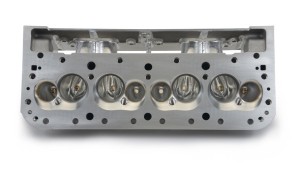
CNC porting can open up the intake and exhaust ports for better airflow. The same port profile can be replicated with a new casting.
Go with the Flow
A common question that’s often asked is whether CNC ported heads outperform as-cast heads? It depends on the head.
If the intake runner profiles of an as-cast head are identical to those of a fully CNC-ported head, both heads should flow exactly the same.
There may be subtle differences in airflow based on the surface finish in the ports, but basically the numbers should not differ significantly.
That said, most CNC-ported heads are marketed as offering a significant advantage over the typical as-cast head. CNC heads can start out as rough castings which are then machined to final dimensions, or as cast heads (stock or performance) which are then reworked by CNC machining to increase intake and exhaust runner volumes and/or reshape the runner profile for more airflow.
You usually pay more for CNC heads because of the extra machine work that’s done to them. But if you can get the same performance from an as-cast head with similar port configurations, the latter can save you money.
Speaking Volumes
Heads are available with various combustion chamber volumes. Larger chambers can accommodate domed pistons and are often compatible with a wider range of aftermarket pistons, while smaller combustion chambers allow you to achieve a higher compression ratio using flat top pistons or smaller domed pistons.
Many head suppliers can also mill a set of heads to reduce the combustion chamber volumes to your specifications if that’s what you want.
An important point to remember here is to always check valve-to-piston clearance with the head installed on the block to make sure there are no interference problems at peak valve lift. Milled heads, larger diameter valves, reduced deck height, a higher lift cam and/or rocker arm ratio can all add up to create interference problems if you fail to take everything into account.
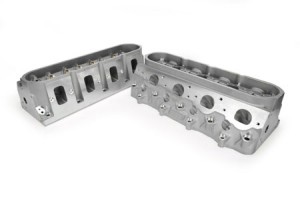
The “right” cylinder head on an engine will deliver peak power in the RPM range where you want it.
Port Points
Raised ports or relocated ports generally provide better airflow and more power. But changing the ports also means you have to change the intake manifold and/or exhaust manifold/headers. On big block Chevy, you also have the option of going with rectangular ports or oval ports. Some say oval ports flow better, but again compatibility with existing manifolds may be the deciding factor as to which port configuration you choose.
What’s Your Angle?
The angle of the spark plug doesn’t matter as much as its location with respect to the valves. On many heads, relocating the spark plug closer to the exhaust valve adds some horsepower. But relocated plugs or different plug angles may interfere with some exhaust manifolds or headers. Consequently, you may have to choose a set of heads that will work with an existing set of manifolds or headers over a set of heads that won’t.
Final Thoughts
Other items to consider when choosing a set of heads includes valve sizes (intake and exhaust), the quality of the valve seat material, the type of valve guides (integral, bronze, powder metal or cast iron), and the diameter and location of the spring pads (larger pads can accommodate larger, stiffer springs).
Do you want assembled heads ready to install, fully machined and unassembled heads you can assemble yourself, semi-finished heads so you can do the final valve work and assembly, or raw castings that you can CNC machine yourself in-house?
Some head suppliers have mass-produced fully assembled heads that are typically sold through online retailers and performance parts distributors. These are a good value for the DIY engine builder or somebody with a limited budget, but are probably not the best choice for most professional engine builders. Many engine builders want full control over the final valve work and assembly to make sure the heads are finished to their specifications.
Get Advice
If you’re confused by the bewildering array of cylinder head configurations that are available in the aftermarket today and need help choosing the right head for your engine, use the expertise of the people who make the heads to help you in the selection process. As we said earlier, they know their product lines and can steer you towards the best head for what you want to accomplish.
The post Don’t Gamble When Choosing Cylinder Heads appeared first on Engine Builder Magazine.
Read more here: Engine Builder Magazine
Category: Featured, Features, Tech Center, cylinder heads




